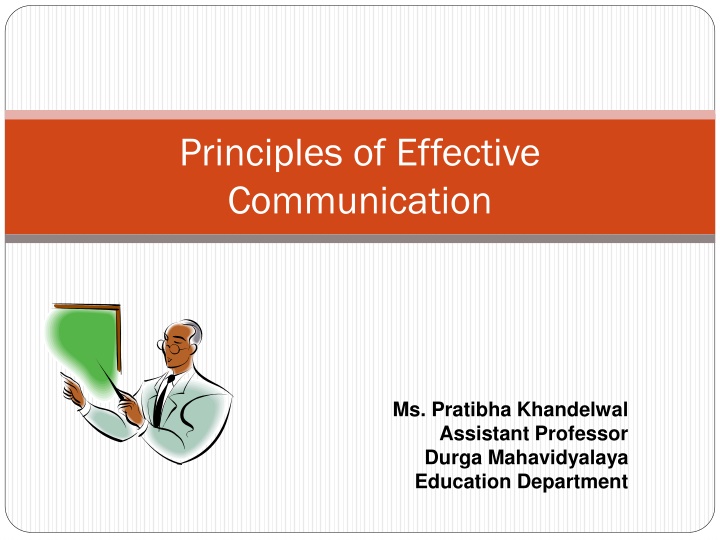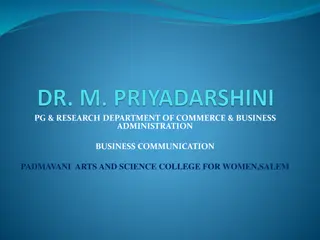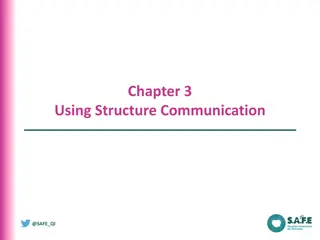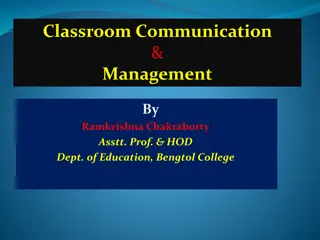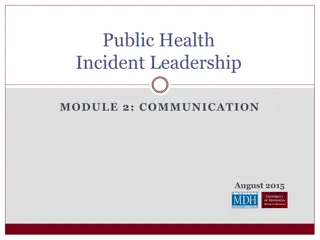Principles of Effective Communication by Ms. Pratibha Khandelwal
Principles of Effective Communication outlined by Assistant Professor Ms. Pratibha Khandelwal focus on vital aspects such as Clarity, Completeness, Conciseness, Consideration, Courtesy, Correctness, and Concreteness. These principles emphasize the importance of clear expression, factual completeness, succinctness, reader consideration, courtesy in communication, and using the right medium for effective messages.
Download Presentation

Please find below an Image/Link to download the presentation.
The content on the website is provided AS IS for your information and personal use only. It may not be sold, licensed, or shared on other websites without obtaining consent from the author.If you encounter any issues during the download, it is possible that the publisher has removed the file from their server.
You are allowed to download the files provided on this website for personal or commercial use, subject to the condition that they are used lawfully. All files are the property of their respective owners.
The content on the website is provided AS IS for your information and personal use only. It may not be sold, licensed, or shared on other websites without obtaining consent from the author.
E N D
Presentation Transcript
Principles of Effective Communication Ms. Pratibha Khandelwal Assistant Professor Durga Mahavidyalaya Education Department
Seven Cs of Communication Seven C s of Communication Principle of Clarity Principle of Completeness Principle of Conciseness Principle of Consideration Principle of Courtesy Principle of Correctness Principle of Concreteness
Principle of Clarity Principle of Clarity Clarity of Thought ( objective of communication, content and which medium is best) Clarity of Expression use simple words; visualize/show use single words; all the time/always use verbs for nouns; make a decision/decide avoid double entry; end result/result avoid jargon; ultimo/previous month avoid ambiguity, faulty punctuation use short sentences
Principle of Completeness Principle of Completeness Completeness of facts is absolutely necessary One should organize the message in such a way that the receiver has no doubt about anything While answering, make sure to answer all the questions. Checking for who, what, where, when, why and how helps to make the message complete.
Principle of Conciseness Principle of Conciseness Be as brief as possible, but brevity should not be effected at the cost of clarity, correctness, completeness, courtesy or appropriateness. Include only relevant facts Avoid repetition Avoid verbosity Avoid wordy expression Organize the message well
Principle of Consideration Principle of Consideration Message must show consideration for the reader. It implies respect for the reader s point of view. Adopt you-attitude Avoid gender bias Emphasize positive facts Emphasize pleasant facts (cheap/economical) Impart integrity to your message (stay away from flattery, say only things which you mean, be sincere and honest)
Principle of Courtesy Principle of Courtesy Courtesy begets courtesy, so be courteous. Answer the letter promptly Do not use offensive language Apologies sincerely for any omissions Thank profusely for any favors Use empathetic language
Principle of Correctness Principle of Correctness It is important to transmit correct facts in correct language. If a message involves any legal matter one should know the correct legal position before committing anything. Give correct facts and information Send the message at the correct time Send the message in the correct style (one should keep in mind the qualities of the receiver)
Principle of Concreteness Principle of Concreteness Concreteness means vivid description of an event/state. Concrete expressions create visual images that are easy to register. Piece of jewellery /earrings High interest/9% Many or few/ 98 or 8
